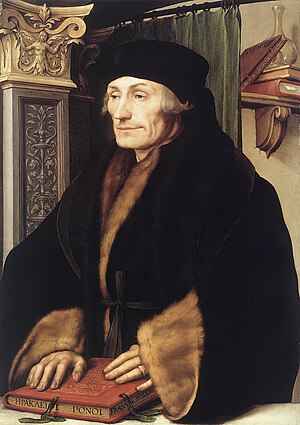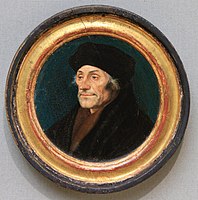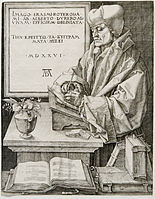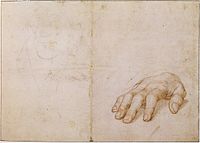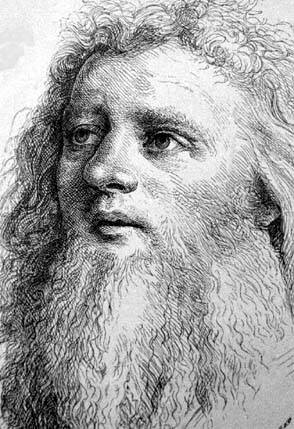
Hans Holbein the Elder was a German painter.
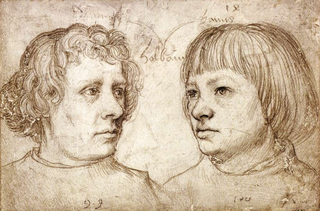
Ambrosius Holbein was a German and later a Swiss artist in painting, drawing, and printmaking. He was the elder brother, by about three years, of Hans Holbein the Younger, but he appears to have died in his mid-twenties, leaving behind only a small body of work.

Hans Holbein the Younger was a German-Swiss painter and printmaker who worked in a Northern Renaissance style, and is considered one of the greatest portraitists of the 16th century. He also produced religious art, satire, and Reformation propaganda, and he made a significant contribution to the history of book design. He is called "the Younger" to distinguish him from his father Hans Holbein the Elder, an accomplished painter of the Late Gothic school.

Johann Froben, in Latin: Johannes Frobenius, was a famous printer, publisher and learned Renaissance humanist in Basel. He was a close friend of Erasmus and cooperated closely with Hans Holbein the Younger. He made Basel one of the world's leading centres of the book trade. He passed his printing business on to his son, Hieronymus, and grandson, Ambrosius Frobenius.

The Kunstmuseum Basel houses the oldest public art collection in the world and is generally considered to be the most important museum of art in Switzerland. It is listed as a Swiss heritage site of national significance.

The Body of the Dead Christ in the Tomb is an oil and tempera on limewood painting created by the German artist and printmaker Hans Holbein the Younger between 1520 and 1522.

Portrait of Sir Thomas More is an oak panel painting created in 1527 by the German artist and printmaker Hans Holbein the Younger, now in the Frick Collection in New York.

Portrait Miniature of Margaret Roper is a painting by the German artist and printmaker Hans Holbein the Younger created during 1535–36, and today held in the Metropolitan Museum of Art in New York. Margaret Roper (1505–44) was the eldest child of Sir Thomas More and wife of the English biographer William Roper. It is the second and less well-known of two portraits of Roper painted by Holbein. The first, Portrait of an English Woman, is generally believed to show Roper but may depict another unknown lady of the English court. The New York work was painted during the artist's second visit to London, likely in the mid-1530s.

Venus and Amor is painting by Hans Holbein the Youngers workshop and is the collection of the Kunstmuseum Basel, Switzerland. It was assumed for a long time to be painting by Hans Holbein the Younger, but research showed that this could not be possible. It was discovered that the painter had used a sort of carbon paper with the contours of the already existing Laïs and used it to transfer those contours in reverse on the new portrait he was to paint of Venus.

The Darmstadt Madonna is an oil painting by the German-Swiss artist Hans Holbein the Younger. Completed ca. 1526—1530 in Basel, the work shows the Bürgermeister of Basel Jakob Meyer zum Hasen, his first wife, his current wife, and his daughter grouped around the Madonna and infant Jesus.

Lais of Corinth is an oil-and-tempera painting on wood completed in 1526 by the German-Swiss Northern Renaissance painter Hans Holbein the Younger. It portrays the famous Lais of Corinth, a courtesan of ancient Greece who charged a high price for her favours. It has been suggested that Holbein is also referring to the Lais who was the lover of Apelles, the great painter of antiquity. The model, the same used for the Venus and Amor, has been identified as either Magdalena Offenburg or her daughter Dorothea, as it was noted by Basilius Amerbach in the archives from the Amerbach-Cabinet, that the woman depicted was someone of the Offenburg family. Dorothea would have been eighteen years of age in 1526. It was assumed that either of the two may have been Holbein's mistress. Both paintings, the Venus as the Lais, came into the possession of the Amerbach Cabinet in the late 1500s.
The Amerbach Cabinet was a collection of artifacts, paintings, libraries, assembled by members of the Amerbach family, most notably by the two law professors of the University of Basel, Bonifacius Amerbach and his son Basilius Amerbach the Younger.

Sir Thomas More and Family is a lost painting by Hans Holbein the Younger, painted circa 1527 and known from a number of surviving copies.

Portrait of Erasmus is a late period 1526 copper engraving by the German artist Albrecht Dürer. The portrait was commissioned by the Dutch Renaissance humanist Desiderius Erasmus of Rotterdam when the two men met in the Netherlands between 1520 and 1521. Erasmus was then at the height of his fame and required representations of himself to accompany his writings. It was not completed until some six years later, but proceeds a number of preparatory sketches.
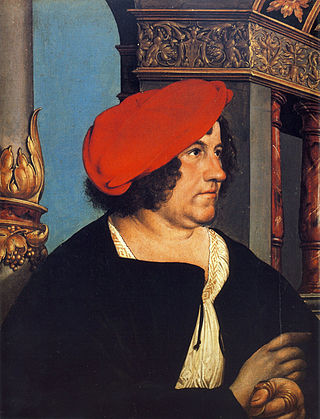
The Double Portrait of Jakob Meyer zum Hasen and Dorothea Kannengießer is a 1516 oil-on-limewood panel painting by the German-Swiss Northern Renaissance master Hans Holbein the Younger. The two panels were commissioned by Jakob Meyer zum Hasen, mayor of Basel, and show him and his second wife Dorothea Kannengießer. The occasion for the portrait could be Meyer zum Hasen's election as the mayor the same year. Holbein was eighteen years old at the time and had arrived in Basel together with his brother Ambrosius only in 1515. He signed with the letters HH. He received the right to sign with his full name in 1519, when he was accepted as a member of the painters' guild of Basel.
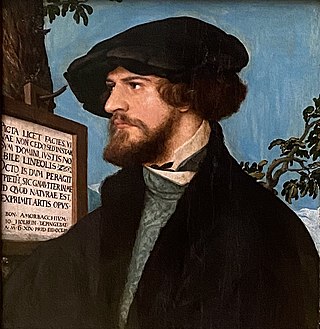
Bonifacius Amerbach was a jurist, scholar, an influential humanist and the rector of the University of Basel for several terms.

The Portrait of Bonifacius Amerbach is a painting by the German master of the Renaissance Hans Holbein the Younger. It is deposited in the Basler Kunstmuseum as part of the Amerbach Cabinet. It is painted in mixed technique on pine panel and measures 29.9 cm x 28.3 cm.

Portrait of the Artist's Family is a portrait of the family of the painter Hans Holbein the Younger by the artist himself. It depicts Holbein's wife Elsbeth Binzenstock, their son Philipp and their daughter Katharina. Holbein painted it during his stay in Basel after his return from England. It was painted, between 1528 and 1529, on paper and glued on wood.
